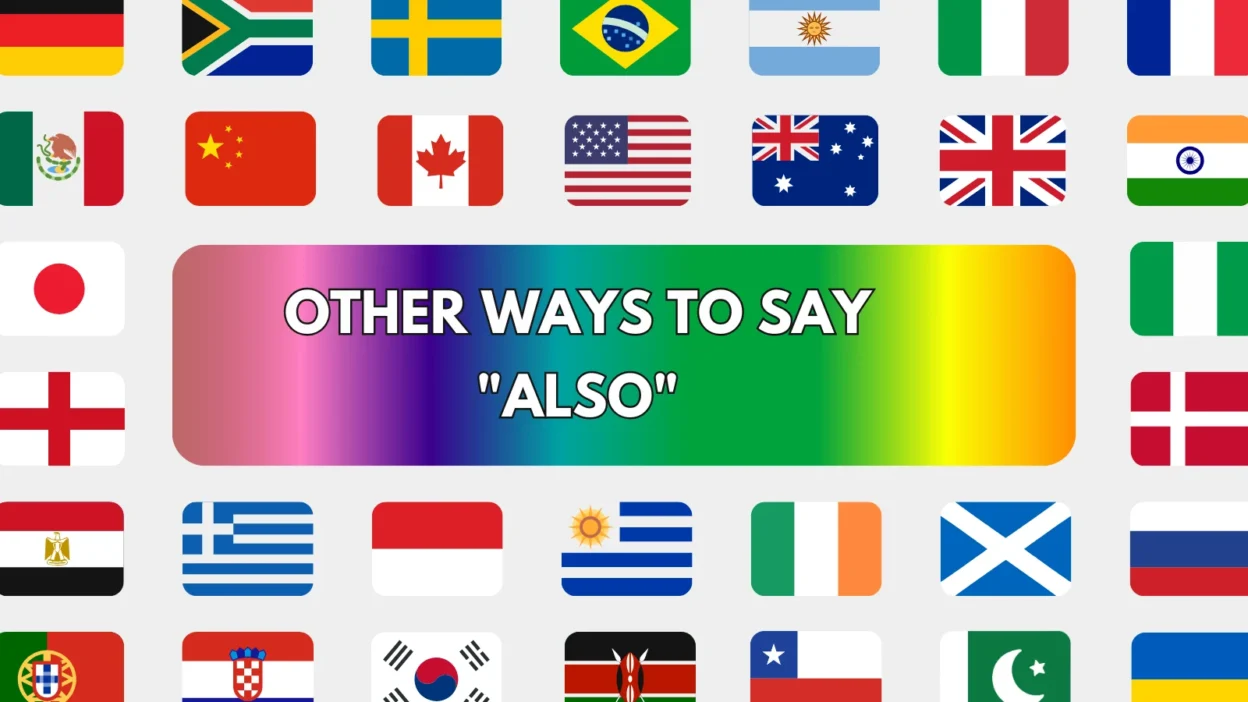The word “also” is a simple and useful way to connect ideas, add information, or show similarity in writing and conversation. However, overusing “also” can make your communication sound repetitive or dull. Whether you’re writing an email, essay, or message, having a variety of alternatives can improve flow, readability, and style.
In this article, you’ll discover 25 effective alternatives to the word “also”, each explained with its meaning, detailed explanation, example sentence, best use, and tone. Let’s dive in and upgrade your transitions and add-ons with confidence!
1. In Addition
Meaning:
Used to introduce more information that supports or builds on what was previously said.
Detailed Explanation:
This formal alternative is perfect when adding new points, especially in professional writing or presentations.
Scenario Example:
In addition to her marketing role, she handles client relations.
Best Use:
Business writing, academic essays, formal emails.
Tone:
Professional, polished, informative.
2. Moreover
Meaning:
Used to introduce further information that adds emphasis or strengthens a point.
Detailed Explanation:
“Moreover” is ideal when you want to build momentum and add persuasive weight to your statement.
Scenario Example:
The plan is cost-effective. Moreover, it saves time.
Best Use:
Formal reports, essays, persuasive writing.
Tone:
Formal, assertive, academic.
3. Furthermore
Meaning:
Adds extra, reinforcing information in a structured way.
Detailed Explanation:
Similar to “moreover,” but often used in logical or explanatory contexts.
Scenario Example:
She’s a great designer. Furthermore, she has excellent leadership skills.
Best Use:
Academic, business, logical arguments.
Tone:
Professional, reasoned, formal.
4. As Well
Meaning:
Means “too” or “also” and is often placed at the end of a sentence.
Detailed Explanation:
It’s less formal and suits casual conversations or simple sentences.
Scenario Example:
I’ll be attending the meeting as well.
Best Use:
Everyday conversation, friendly writing.
Tone:
Polite, neutral, conversational.
5. Too
Meaning:
Used to indicate that something applies in addition to something else.
Detailed Explanation:
Extremely common in both speech and writing. It’s usually placed at the end of the sentence.
Scenario Example:
She likes chocolate, and I do too.
Best Use:
Informal communication, friendly chats.
Tone:
Casual, simple, friendly.
6. Additionally
Meaning:
Introduces another idea or point that supports the current discussion.
Detailed Explanation:
Formal and precise, often found in technical or professional writing.
Scenario Example:
Additionally, we will implement new safety protocols.
Best Use:
Emails, reports, structured writing.
Tone:
Professional, clear, structured.
7. What’s More
Meaning:
Adds an extra or surprising point, sometimes with emphasis.
Detailed Explanation:
This phrase adds drama or excitement to a point you’re building on.
Scenario Example:
The event was fun. What’s more, it raised a lot of money.
Best Use:
Marketing, storytelling, informal persuasive writing.
Tone:
Energetic, engaging, informal.
8. Likewise
Meaning:
Shows similarity or agreement with a previous idea.
Detailed Explanation:
“Likewise” is used when you’re aligning your statement with something already mentioned.
Scenario Example:
She enjoys early morning runs. Likewise, I find them refreshing.
Best Use:
Comparative writing, formal and casual speech.
Tone:
Balanced, polite, affirming.
9. Not to Mention
Meaning:
Used to add an extra point that reinforces the previous ones.
Detailed Explanation:
Implies the next detail strengthens the case, often dramatically.
Scenario Example:
He’s an amazing chef, not to mention a talented musician.
Best Use:
Storytelling, marketing, opinion writing.
Tone:
Emphatic, persuasive, informal.
10. Along With That
Meaning:
Adds a related or connected piece of information.
Detailed Explanation:
More conversational than “in addition,” and smoother in spoken contexts.
Scenario Example:
She’s studying biology. Along with that, she’s working part-time.
Best Use:
Casual writing, everyday conversations.
Tone:
Friendly, relaxed, clear.
11. As Well As That
Meaning:
Adds a point that is equally important or notable.
Detailed Explanation:
Useful in layered explanations or detailed comparisons.
Scenario Example:
As well as that, he brings years of experience in finance.
Best Use:
Professional summaries, thoughtful speech.
Tone:
Polished, informative, formal.
12. On Top of That
Meaning:
Adds extra information, often with emphasis.
Detailed Explanation:
Can be used to stack up benefits, responsibilities, or challenges.
Scenario Example:
She’s managing a team. On top of that, she’s taking night classes.
Best Use:
Conversations, persuasive writing, dynamic speech.
Tone:
Informal, strong, engaging.
13. In the Same Way
Meaning:
Indicates similarity between ideas or actions.
Detailed Explanation:
Ideal when making comparisons or drawing parallels.
Scenario Example:
In the same way that we handled the last project, we’ll start this one.
Best Use:
Essays, professional writing, analysis.
Tone:
Logical, formal, balanced.
14. By the Same Token
Meaning:
Adds a comparable idea or reinforces a previous point.
Detailed Explanation:
Slightly formal and often used in arguments or counterpoints.
Scenario Example:
He dislikes long meetings. By the same token, he prefers clear agendas.
Best Use:
Essays, debates, opinion writing.
Tone:
Analytical, formal, intellectual.
15. And
Meaning:
Simple word used to join two or more related ideas.
Detailed Explanation:
The most basic alternative, but when used skillfully, it’s very effective.
Scenario Example:
She sings and plays the guitar.
Best Use:
All contexts — writing and speech.
Tone:
Neutral, flexible, universal.
16. Together With
Meaning:
Indicates two or more things happening or existing at the same time.
Detailed Explanation:
Used when combining or grouping items, ideas, or people.
Scenario Example:
Together with her team, she launched the new app.
Best Use:
Professional writing, descriptive communication.
Tone:
Clear, professional, organized.
17. In Like Manner
Meaning:
Expresses that something happens in the same or similar way.
Detailed Explanation:
A more traditional or academic alternative.
Scenario Example:
In like manner, the second group completed their task early.
Best Use:
Academic, formal writing.
Tone:
Formal, classic, structured.
18. Too Much So
Meaning:
Adds more information but often suggests it may be excessive.
Detailed Explanation:
Used when the extra point adds intensity or criticism.
Scenario Example:
He’s passionate — too much so at times.
Best Use:
Reflective writing, nuanced opinion.
Tone:
Slightly critical, thoughtful, personal.
19. Just Like
Meaning:
Highlights similarity, especially in actions or situations.
Detailed Explanation:
Helps emphasize how two things resemble each other.
Scenario Example:
Just like her brother, she’s excellent at chess.
Best Use:
Casual conversation, comparisons.
Tone:
Simple, friendly, relatable.
20. Plus
Meaning:
Adds extra information, often casually.
Detailed Explanation:
Short, snappy, and great for listing benefits or features.
Scenario Example:
The camera’s lightweight. Plus, it has great battery life.
Best Use:
Marketing, everyday speech, advertising.
Tone:
Upbeat, informal, quick.
21. Also Worth Mentioning
Meaning:
Highlights that a new point is relevant or notable.
Detailed Explanation:
Used to draw attention to something you don’t want the reader or listener to miss.
Scenario Example:
Also worth mentioning — he’s fluent in three languages.
Best Use:
Emails, resumes, structured summaries.
Tone:
Informative, clear, professional.
22. Not Only That
Meaning:
Introduces an additional point with strong emphasis.
Detailed Explanation:
Works well in persuasive or impressive contexts.
Scenario Example:
She passed the test. Not only that, she got the highest score.
Best Use:
Persuasive writing, dramatic storytelling.
Tone:
Excited, assertive, engaging.
23. Then Again
Meaning:
Adds a contrasting or reconsidering idea (often informal).
Detailed Explanation:
Useful when adding information that shifts the perspective slightly.
Scenario Example:
I might skip the trip. Then again, I could use a break.
Best Use:
Casual writing, friendly dialogue.
Tone:
Thoughtful, informal, flexible.
24. Likewise So
Meaning:
Means “similarly” or “in the same way.”
Detailed Explanation:
Not as common as “likewise,” but still effective in echoing a point.
Scenario Example:
They stayed up all night preparing. Likewise so did the interns.
Best Use:
Storytelling, formal speeches, narrative writing.
Tone:
Formal, elegant, literary.
25. Let’s Not Forget
Meaning:
Draws attention to something important you’re adding.
Detailed Explanation:
Adds emphasis to the next point, reminding the reader it’s significant.
Scenario Example:
Let’s not forget how much effort the volunteers contributed.
Best Use:
Emphatic writing, speeches, personal letters.
Tone:
Engaging, persuasive, warm.
Conclusion
While “also” is a simple and useful word, relying on it too much can flatten your writing or speech. With these 25 vibrant alternatives, you can vary your tone, adjust for formality, and communicate your ideas more clearly and compellingly.




